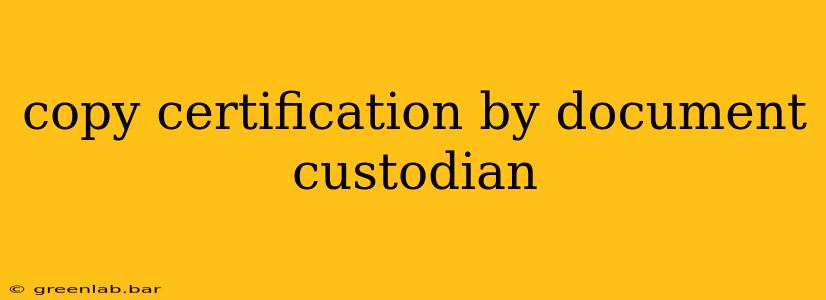Obtaining a certified copy of a document is crucial in various legal and administrative processes. This guide delves into the intricacies of copy certification by a document custodian, explaining the process, its importance, and the legal implications involved. We'll explore the requirements, potential pitfalls, and best practices to ensure a smooth and legally sound certification.
Understanding Copy Certification
Copy certification is the process of verifying the authenticity of a document copy by an authorized individual, often the document custodian. This person attests that the copy is a true and accurate reproduction of the original document. This attestation carries significant legal weight, ensuring the copy's admissibility in legal proceedings and its acceptance in official contexts.
Who is a Document Custodian?
A document custodian is an individual or entity entrusted with the responsibility of maintaining and safeguarding original documents. This role varies depending on the context:
- In organizations: This could be a records manager, archivist, administrative assistant, or any designated employee with access and responsibility for the original documents.
- In legal settings: Law firms, courts, and government agencies have specific individuals designated as custodians of their respective records.
- In personal contexts: While less formalized, the custodian could be the individual possessing the original document and responsible for its safekeeping.
The Process of Copy Certification
The process typically involves these steps:
-
Verification of the Original: The custodian carefully examines the original document to verify its authenticity and integrity. This includes checking for any alterations, damage, or inconsistencies.
-
Creation of a True Copy: A faithful reproduction of the original document is created. This can be through photocopying, scanning, or other methods ensuring the copy accurately reflects the original.
-
Certification Statement: The custodian prepares a written certification statement. This statement typically includes:
- Identification of the Document: Precise details about the document, including its title, date, and identifying number (if any).
- Affirmation of Accuracy: A clear declaration that the attached copy is a true and accurate reproduction of the original document.
- Custodian's Details: The custodian's full name, title, organization (if applicable), and contact information.
- Date of Certification: The date the certification is made.
- Signature and Seal (where applicable): The custodian's signature and an official seal (if required by the organization or jurisdiction).
-
Attachment of the Certification: The certification statement is securely attached to the copy of the document. This could involve stapling, sealing, or other methods ensuring the connection.
Legal Implications and Best Practices
The legal implications of copy certification are significant. A flawed or improperly executed certification can render the copy inadmissible or unreliable. To minimize risks:
- Ensure Proper Authority: Verify the custodian possesses the legal authority to certify copies. Questions about authority should be addressed before the process begins.
- Maintain a Chain of Custody: Document the handling and storage of both the original and the copy to establish a clear chain of custody. This is crucial for legal admissibility.
- Use Appropriate Methods: Employ reliable copying methods to ensure the copy's accuracy and prevent alterations.
- Secure Storage: Store both the original and certified copy securely to prevent loss, damage, or unauthorized access.
- Seek Legal Advice (when necessary): For complex cases or high-stakes situations, consulting legal counsel is advisable to ensure compliance with all relevant laws and regulations.
Conclusion
Copy certification by a document custodian is a vital process for verifying the authenticity of documents. Understanding the process, its legal implications, and best practices is crucial for maintaining the integrity of your documents and ensuring their acceptance in various contexts. Following the guidelines outlined above will help ensure a smooth and legally sound certification, minimizing risks and avoiding potential complications.

